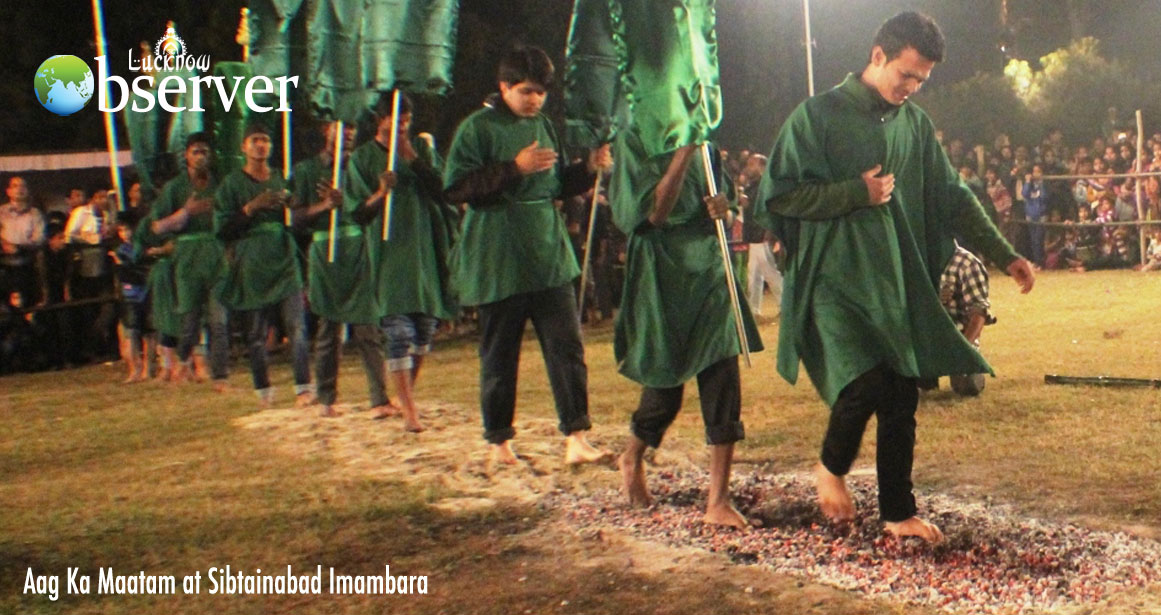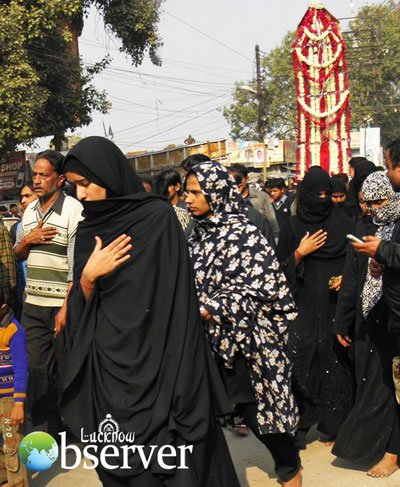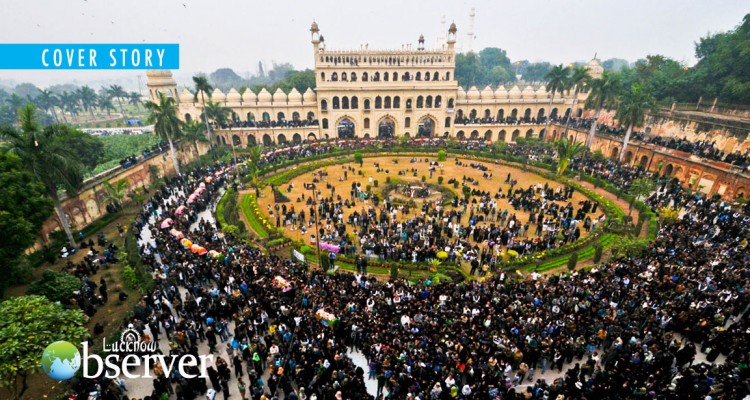Muharram- the first month of the Islamic calendar. The citing of the crescent, which marks the onset of Muharram, is done with welled up eyes. For this is the month when the grandson of the Prophet Muhammad (peace be upon him) was matryed with 72 followers in the battle of Karbala in 61 A.H. as per Islamic calendar. Imam’s Hussain’s sacrifice is regarded as the supreme sacrifice of humanity. It wasn’t any ordinary battle that was fought between two political rivals over the question of succession but it was a battle between ‘haq’ and ‘baatil’ – truth and falsehood.
The battle of Karbala occurred on the 10th of Muharram, which was on 10th October, 680 A.D., following a series of bitter diplomatic exchange of dialogues and dwindling attempts at peace in the last ten days between Imam Hussain’s camp and the army sent by Yazid, son of Muawiyah.
While Muslims in general mourn the martyrdom of Imam Hussain all over the world, it is mainly the Athna Ashari or The Twelver Shias who observe the mourning for 68 days commencing from the first day of Muharram.
Lucknow, one of the largest concentration of Twelvers is present in India, became an important centre of mourning during Muharram or Azadari, under the patronage of the Nawabs who had Persian roots and were Twelvers in faith. However, Azadari, or the mourning of Imam Hussain is not exclusive to the Shias as even today there are hundreds of Sunni Muslims as well as Hindus who practice Azadari.
Background To Muharram
Imam Hussain arrived in Karbala, on the 2nd of Muharram, with his small band of followers which included women and children. He was invited by Yazid who was then the Umayyad Caliph and was then the Umayyad Caliph and wanted an oath of allegiance. Later, while everyone was threatened and made to accept their allegiance to Yazid, Hussain ibn Ali refused so and confronted Yazid openly. Hussain was the most significant threat to Yazid as he was the only living grandson of Prophet Muhammad. When Yazid sent his Governor, Walid in Medina to Imam Hussain to pledge allegiance to him, then Imam Hussain said, “Anyone akin to me will never accept anyone akin to Yazid as a ruler.” Later, Yazid appointed Amr ibn Sa’ad ibn al Aas as the head of an army, ordering him to take charge and kill Hussain wherever he could find him during Hajj. Hence, Imam Hussain decided to leave Mecca on 8th Zil Hajj 60AH (12th Sep 680 AD), just a day before Hajj and converted his Hajj into Umrah so that the sanctity of the Holy Kaaba was maintained and there was no bloodshed on the sacred soil.
Imam Hussain reached Karbala, also called Ninevah on 2nd Muharram. Imam Hussain’s caravan had women and children too and in order to weaken him, Yazid’s army stopped the supply of water from the River Euphrates. As a result, the followers of Imam Hussain were kept thirsty for three days in the scorching and blistering heat of the desert. While the men valiantly fought in the battle of Karbala on 10th Muharram- A’ashura, and were ultimately martyred, thirsty and parched; the women and children were taken as prisoners. On the surface it appeared that Yazid had won the war but the supreme sacrifice of Imam Hussain turned public opinion against Yazid and truth prevailed.

Lucknow Aur Azadari
Azadari or mourning in Lucknow assumed great significance during the Nawabs. While the Mughals were mainly Sunni’s, the Nawabs came from Persia, present day Iran, and brought with them, their culture and traditions. The processions of Muharram were started during the reign of Nawabs. Processions like Shahi Zari, Juloos- e-Mehndi, Alam-e-A’ashura, Alam-e-Fateh- e-Furaat and Chup Tazia have great significance here.
In the festival register of the Waqf Board, there are more than 900 processions that are registered. However, because of the tensions between Sunnis and Shias, all the processions were banned in 1977. With a lot of deliberations, and mounting pressure from the Shias, the government allowed nine Shia processions and one Sunni procession to be taken out from 1998. However, it is to be noted that even today, hundreds of Sunnis as well as Hindus take part in Muharram processions with great zeal and fervour. As the famous couplet of Josh Malihabadi says:

“Insaan Ko Bedaar Toh Ho Lene Do,
Har Qaum Pukaregi Hamare Hain Hussain”
Apart from the religious zeal, Muharram also became a pretext for poets and artists to emotionally charge people with their poetry and art to wring the maximum tears from a person’s eye.
As soon as the crescent of Muharram shines on the firmament, the city of Lucknow is blanketed with grief. Such was the supreme sacrifice of Imam Husain that even after 1400 years; people only wear black as a symbol of mourning. And if grief has myriad shades, it has to be seen during Muharram in Lucknow. The great procession of Shahi Zari is taken out from Bara Imambara on 1st Muharram. With a couple of camels, elephants and hundreds of Alams (flags), the present day Shahi Zari is only reminiscent of the grand Shahi Zari taken out during the Nawabs. However, the silver staffs and Alams are the same that are being used since the days of the Nawabs. Every inch of land is covered with people who pour out on the stretch in front of Bara Imambara in Husainabad. Men, women and children alike are dressed in jet black clothes and the rhythmic murmur of Ya Hussain along with the sound of the clarinet and the cymbals emitting a dirge like music indeed fills the air with grief and anguish. In the centre of every group of chanters, called Anjuman, is a nauhakhwan or a marsiyakhwan, narrating the events of Karbala in a lyrical way (nauha) or simply reciting in form of couplets (marsiya). Lucknow, during the reign of the Nawabs became a centre of Azadari and as a result also an epicentre of Marsiyas, Soz and Nauha.

Another prominent procession is the Juloos-e-Mehndi which is taken out on the 7th of Muharram. It is said that Imam Hussain’s nephew, Hazrat Qasim ibn Hasan ibn Ali, was gotten married during the stay in Karbala a couple of days before the battle in which he was eventually martyred. To commemorate Hazrat Qasim’s, the young groom’s wedding to Bibi Kubra, a grand procession is taken out from Bara Imambara. Leaves of Mehndi (Henna) are placed along with lit up candles and other paraphernalia of a traditional wedding. The short-lived happiness of a wedding only brings more tears when one thinks of the fate of the groom who was martyred thirsty in the Battle of Karbala.
The most sombre yet passionate procession is that of Alam-e-Fateh-e- Furaat that is taken out on 8th Muharram from Dariya wali Masjid and culminates at Gufran Ma’ab Imambara. This juloos is also called ‘Mashalon wala Alam’ in local parlance, as the Alam (flag) of Hazrat Abbas (brother and commander of Imam Hussain) is flanked by numerous mashals or torches that are carried in the dead of the night by mourners who swell on the streets in lakhs. The otherwise eerie silence of the night is broken by the slogan of ‘Ya Sakina Ya Abbas’ coupled with the beating of chest in a rhythm (matam) that crescendos into a fevered pitch every 10-15 minutes. Lovers of Imam Hussain and Hazrat Abbas, the valiant martyr, come from far and wide, barefoot to take part in the procession.
It is to be noted, that during Muharram every street in Lucknow is dotted with a number of Sabeels or temporary tents put up to serve water to everyone. While Imam Hussain was martyred without being given even a drop of water, his lovers and followers offer water to everyone, irrespective of caste, creed or religion, remembering the thirst of the Holy Imam and his companions.
The last prominent procession during the first ten days is Alam-e- A’ashura, taken out on 9th Muharram from the Imambara of Nazim Sahab in Nakhas. This is the night right before the 10th Muharram or A’ashura. Imam Hussain had asked a night’s time before the battle to pray to Allah. It is called Ibadat ki raat or the night of worship. This was also the night when one of Yazid’s commanders, Hazrat Hurr, changed his allegiance and came to Imam Hussain’s side with his son. Nobody sleeps during this night and mostly pray and visit the holy shrines, dargahs and Imambaras.
A’ashura meaning ‘ten’ is the tenth day of Muharram and the fateful day when Imam Hussain was martyred with his companions in Karbala. The Sabeel’s don’t serve water on this day. Mostly Sunni Muslims fast on this day while Shia Muslims do not do anything till Asr prayers or late afternoon. In Lucknow and neighbouring areas, it’s a local tradition to make a simple meal of rice and black masur dal along with sherbet. Eating of this meal after the late afternoon prayers is called Faaqa Shikani.
During the first ten days of Muharram, the Imambara of Gufran Ma’ab near King George’s Medical University, perpetually echoes with the sound of Majlis (gatherings to commemorate the tragedy of Karbala).
Lucknow is literally drenched in an ocean of gloom during Muharram but the mourning and the grief paradoxically brings alive a yet another facet of this wondrous city of Lucknow.
“Qatl–e Hussain, Asl Mein Marg-e Yazid Hai
Islam Zinda Hota Hai, Har Karbala Ke Baad”
Marsiya Khwani And Soz Khwani
Marsiya Khwani and Soz Khwani both narrate the events of the tragedy of Karbala. However, the minor difference is that Marsiya Khwani involves ‘Tahtul lafz khwani’ or reciting in a dramatic way without any musical element, just like a poet recites poetry in a Mushaira sans ‘tarannum’ (rhythm), whereas Soz Khwani involves ‘singing’ of the couplets that narrate the tragedy of Karbala. Soz Khwani became an art in Lucknow. While Mir Anees and Mirza Dabeer need no introduction for their invaluable contributions to Marsiya Khwani, it’s worthy to mention some of the famous Soz Khwans of yore. Soz Khwani wasn’t limited to Lucknow alone, Madras and Deccan too had their own breed of Soz Khwans and in fact, Marsiyas and Soz that are more than 150 years old are still present. However, reciting the marsiyas in the form of ‘shayari’ was Lucknow’s innovation. The Soz Khwans of Lucknow rose to such popularity that even the professional singers couldn’t match with their prowess and command over the art.
Like other artist, the Soz Khwans of Lucknow got patronage during the reign of Shuja ud Daulah. In Faizabad’s history it’s recorded that Shuja-ud-Daulah’s wife Bahu Begum used to organise Majalis, and one of her nobles, Jawahar Ali Khan ‘Khwajasara’ used to listen to Marsiyas. However, till then Soz Khwani had not got its distinct Lucknawi uniqueness.
Many people say, that Khwaja Hasan Maudoodi was the pioneer of this art. He was the Ustad of the author of ‘Naghmaat- e-Aasifiya’. Although, he wasn’t a professional musician but his proficiency over the art was pretty well-known. He was a Sunni Muslim and most of the present day rhtyhms of Sozs were composed by him. Later, during the times of S. Haidery Khan, the famous Soz Khwan used to pick and choose from a plethora of rhythms that were composed for Soz Khwani. In this way, even Soz Khwani became a formidable art in Lucknow. The most heart wrenching rhtyhms were chosen so as to aptly evoke the pathos of the mourners of Imam Hussain. Haidery Khan taught the art of Soz Khwani to Syed Mir Ali, who was a noble but was immensely attracted to the art. He carved a niche for himself in those days. After that, one Nasir Khan, from the lineage of Tansen came to Lucknow and shone brightly on the cultural sky. Looking at the popularity of Soz Khwani in Lucknow, he diverted his energies, skill and mastery over Soz Khwani. He married a poor widow Saidani (a woman with Syed roots) out of compassion and later taught the art of Soz Khwani to her two sons- Mir Ali Hasan and Mir Banda Hasan, who later outshone all their previous Ustads and were unmatched in their art of Soz Khwani.
Because of the widespread popularity of Soz Khwani, this art started being practised within the walls of common citizens as well. The ladies of the house started practising Nauha Khwani and Soz Khwani and it is said that if these ladies were given a chance to take up Soz Khwani professionally then they would have become a force to reckon with.
To date, in the month of Muharram, it’s the ladies of the house who do Nauha Khwani and Soz Khwani every day in their houses and the neighbourhood where every house has a Taziya (a temporary replica of Imam Hussain’s mausoleum in Karbala made of bamboo, wood and paper, which is ultimately buried on the day of A’ashura).

If I had an army like the 72 soldiers of Hussain, I would have won freedom for India in 24 hours
– Mahatma Gandhi
I have spent more than 20 years in prison, then on one night I decided to surrender by signing all the terms and conditions of government. But suddenly I thought about Imam Hussain and Karbala movement and Imam Hussain gave me strength to stand for right of freedom and liberation and I did.
– Nelson Mandela
Imam Hussain’s sacrifice is for all groups and communities, an example of the path of righteousness
– Pandit Jawaharlal Nehru
In order to keep alive justice and truth, instead of an army or weapons, success can be achieved by sacrificing lives, exactly what Imam Hussain did
– Rabindranath Tagore
The sacrifice of Imam Hussain is not limited to one country, or nation, but it is the hereditary state of the brotherhood of all mankind
– Dr. Rajendra Prasad
I congratulate Muslims that from among them, Hussain, a great human being was born, who is reverted and honored totally by all communities
– Sarojini Naidu
Saira Mujtaba
– Writer is a Delhi based freelance journalist of Lucknow origin
and is fascinated with everything Lucknawi.

